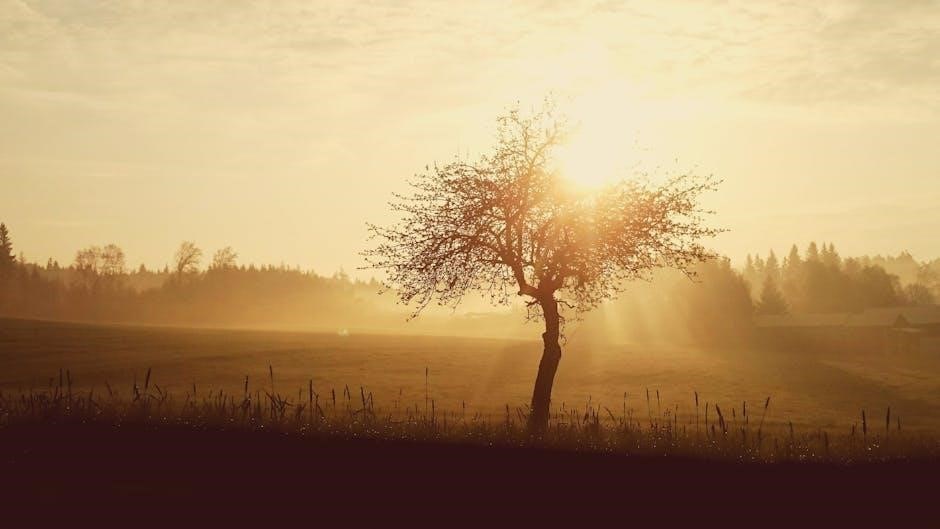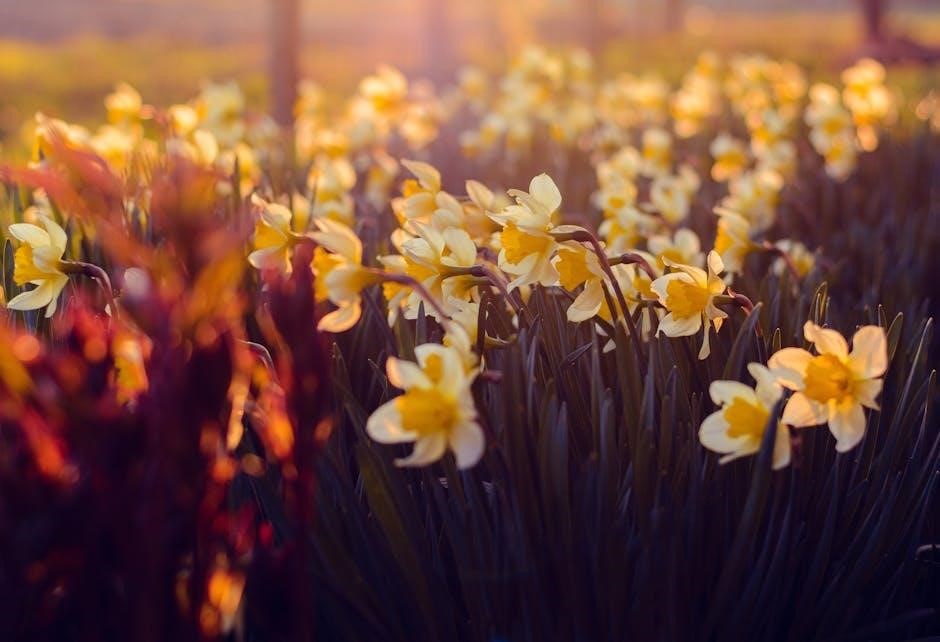Hallucinogenic plants, explored in guides like the “Golden Guide,” represent a fascinating intersection of botany and culture. These plants, containing psychoactive compounds, have been utilized by humans for centuries, influencing spiritual practices and altering perception.
Brief Overview of Hallucinogenic Plants and Their Historical Significance
Hallucinogenic plants, as depicted in texts like the Golden Guide, hold significant historical and cultural importance. They have been employed since ancient times in religious ceremonies and for medicinal purposes, often viewed as sacred conduits to spiritual realms. Archaeological evidence, such as ancient pipes, suggests usage dating back millennia. The plants’ psychoactive effects, stemming from chemical compounds, alter perception and cognition, influencing rituals, art, and even social structures across various civilizations, illustrating their profound impact on human history.
Cultural and Ritualistic Uses
Hallucinogenic plants play pivotal roles in diverse cultures, particularly within ritualistic contexts. These plants facilitate spiritual journeys, connect individuals to ancestral realms, and are integral to shamanic practices across numerous societies.
Hallucinogenic Plants in Ancient Societies
Ancient societies integrated hallucinogenic plants into their spiritual, medicinal, and social practices. Archaeological evidence reveals the use of these plants in rituals dating back millennia. From the Americas to the Mediterranean, various cultures revered plants with psychoactive properties, employing them in ceremonies intended to induce altered states of consciousness. These experiences were often interpreted as divine communication, healing opportunities, or pathways to knowledge. The plants held significant cultural importance, shaping beliefs and traditions within these ancient communities, often guided by shamans and healers.
Modern Ritualistic Use Among Native American Communities
Contemporary Native American communities maintain traditional ritualistic practices involving hallucinogenic plants, particularly peyote. The Native American Church, for example, incorporates peyote ceremonies as a central aspect of their spiritual life. These rituals, often involving communal prayer, singing, and contemplation, are believed to foster healing, spiritual insight, and connection to ancestral wisdom. Despite legal challenges and cultural misunderstandings, these communities continue to uphold their sacred traditions, viewing these plants as integral to their cultural identity and spiritual well-being, promoting morality and ethical behavior.
Common Hallucinogenic Plants
Several hallucinogenic plants are well-known for their psychoactive properties and historical use. Peyote, with its mescaline content, and Salvia divinorum, known for its potency, are prominent examples. These plants have unique chemical compositions and effects.
Peyote: Ritual Use and Effects
Peyote, a spineless cactus, holds significant cultural importance, particularly among Native American communities. Its ritual use dates back centuries, with practitioners consuming it as a means of spiritual exploration. Peyote is not considered addictive and may promote morality and ethical behavior. The primary psychoactive compound in peyote is mescaline, which induces altered states of consciousness, visual hallucinations, and profound introspection. These experiences are traditionally integrated into religious ceremonies and viewed as a way to connect with the divine and gain wisdom.
Salvia Divinorum: Potency and Legality
Salvia divinorum, a member of the mint family, has gained attention for its potent psychoactive effects. Native to Mexico, this herb contains salvinorin A, a powerful kappa opioid receptor agonist. Even small doses can induce intense, short-lived hallucinogenic experiences. Given its growing popularity, including recreational use, the legality of Salvia divinorum varies widely. Some regions have banned or regulated its sale and possession, while others have not. Its potency and differing legal status make responsible use and awareness of local laws essential.

Chemical Compounds and Physiological Effects
Hallucinogenic plants owe their effects to unique chemical compounds. These substances, often alkaloids, interact with the brain. This interaction alters perception, emotion, and cognition. Understanding these mechanisms is crucial to responsible use and to understanding potential risks.
Alkaloids in Hallucinogenic Plants
Alkaloids represent a major class of active compounds within many hallucinogenic plants. These naturally occurring chemical compounds often contain nitrogen and exhibit potent physiological effects on the human body. Alkaloids like psilocybin in mushrooms and mescaline in peyote interact with neurotransmitter systems, primarily affecting serotonin receptors in the brain. This interaction leads to altered sensory perception, changes in mood, and distortions of thought processes. The concentration and specific type of alkaloids present significantly influence the intensity and duration of the hallucinogenic experience, demanding careful consideration.
Effects on Perception, Emotion, and Cognition
Hallucinogenic plants profoundly impact perception, emotion, and cognition by interfering with neurotransmitter systems in the brain. These alterations can manifest as visual and auditory hallucinations, synesthesia (blending of senses), and distortions of time and space. Emotionally, individuals may experience heightened feelings of euphoria, anxiety, or spiritual connection. Cognitive processes are also affected, leading to altered thought patterns, enhanced creativity for some, and confusion or disorientation for others. The specific effects vary depending on the plant, dosage, individual sensitivity, and the surrounding environment or context.
Identification and Differentiation
Correctly identifying hallucinogenic plants is crucial due to the presence of toxic look-alikes. Guides highlight key features like leaf structure, flower color, and growth patterns, aiding in distinguishing safe psychoactive plants from dangerous species.
Distinguishing Hallucinogenic Plants from Toxic Look-alikes
The accurate identification of hallucinogenic plants is paramount, as they often bear resemblance to toxic species. Misidentification can lead to severe health consequences, including poisoning and even death. Guides, such as the Golden Guide to Hallucinogenic Plants, emphasize detailed visual characteristics, including leaf shape, flower structure, and stem patterns, to aid in differentiation. Microscopic features, habitat preferences, and geographical location can further assist in distinguishing between psychoactive and harmful plants, ensuring safe and responsible identification practices. Careful examination and cross-referencing with reliable sources are vital.

Potential Risks and Dangers
Hallucinogenic plants, while culturally significant, can pose risks. Toxicity, unpleasant effects, psychosis, and misidentification dangers exist; Caution and responsible use are crucial when exploring these potent plants.
Toxicity and Unpleasant Effects
Many hallucinogenic plants can induce unpleasant or toxic effects, as highlighted in resources like the “Golden Guide.” Jimsonweed and deadly nightshade serve as stark examples, demonstrating the potential for adverse reactions. These reactions range from nausea and vomiting to more severe physiological distress. Accurate identification is crucial to avoid accidental ingestion. Mistaking hallucinogenic plants for harmless look-alikes, especially mushrooms, can lead to severe consequences and even death. Therefore, thorough knowledge and caution are paramount when dealing with these substances.
Risk of Psychosis and Other Adverse Reactions
The use of hallucinogenic plants carries the risk of triggering psychosis or other detrimental psychological reactions, as cautioned by guides and experts. Individuals with pre-existing mental health conditions are particularly vulnerable. Anxiety, paranoia, and panic attacks are also common adverse effects. Recreational use, especially without proper guidance or understanding, heightens these risks. The potential for long-term cognitive or emotional instability underscores the importance of responsible usage and awareness of individual vulnerabilities when considering these powerful substances.
Medicinal and Therapeutic Applications
Hallucinogenic plants have a deep history in medicine, potentially offering therapeutic value as noted in guides. Current research explores their use for mental health, such as treating anxiety, depression, and even end-of-life distress.
Historical Healing Effects
Throughout history, various cultures have incorporated hallucinogenic plants into their healing practices. Ancient civilizations, as detailed in guides like the “Golden Guide,” recognized the potential of these plants to address physical and mental ailments. Shamans and healers used them in rituals and ceremonies, believing they could connect with spiritual realms and facilitate healing. These plants were employed to treat pain, alleviate depression, and even address psychological disturbances, reflecting a profound understanding of their therapeutic properties within traditional contexts. The exact mechanisms of action were not always understood, but the observed effects were undeniable.
Modern Therapeutic Uses (e.g., Cannabis)
In contemporary medicine, researchers are revisiting the therapeutic potential of hallucinogenic plants, as explored in updated guides. Cannabis, for example, has gained recognition for its medicinal properties, including pain relief, anxiety reduction, and treatment of certain medical conditions. Studies are investigating the use of psilocybin and other compounds in treating depression, PTSD, and addiction. While further research is needed, the initial findings suggest that these plants may offer novel approaches to mental health treatment. The “Golden Guide” provides a historical context for understanding this renewed interest.
Legality and Regulation
The legal landscape surrounding hallucinogenic plants is complex and varies significantly across regions. Many remain illegal due to their psychoactive effects, while some have been decriminalized or legalized for medicinal or religious purposes.
Varying Legal Status of Hallucinogenic Plants
The legal status of hallucinogenic plants presents a global patchwork, influenced by cultural traditions, scientific understanding, and political ideologies. Some countries maintain strict prohibitions, classifying these plants as controlled substances with severe penalties for possession, cultivation, or distribution. Conversely, certain jurisdictions have adopted more lenient approaches, recognizing the historical and cultural significance of these plants in indigenous communities, and are exploring regulated access for therapeutic or religious practices. This divergence reflects ongoing debates about individual liberties, public health, and the potential benefits and risks associated with psychoactive substances.
Growing Psychoactive Plants
Cultivating psychoactive plants requires specific knowledge of their environmental needs. Many enthusiasts grow them for personal use, while others study cultivation methods for conservation purposes. Propagation techniques vary depending on the species.
Cultivation and Propagation
Cultivating psychoactive plants demands a nuanced understanding of their specific needs. Factors such as soil composition, light exposure, and humidity levels play crucial roles in their successful growth. Propagation methods vary widely, ranging from seed germination to cuttings and grafting. Some species thrive indoors under controlled conditions, while others require outdoor environments that mimic their native habitats. Responsible cultivation also includes awareness of potential risks and legal considerations, especially if the plants contain controlled substances. A comprehensive resource, like a golden guide, provides valuable information for enthusiasts and researchers.
Hallucinogenic Plants in Popular Culture
Hallucinogenic plants, once confined to shamanic rites, now permeate popular culture. Their influence extends to art, music, and literature, often romanticizing or demonizing their effects, reflecting society’s complex relationship with altered states of consciousness.
Use in Shamanic Rites and Ceremonies
Hallucinogenic plants hold profound significance within shamanic rites and ceremonies across diverse cultures. These plants facilitate altered states of consciousness, believed to bridge the gap between the physical and spiritual realms. Shamans, acting as intermediaries, utilize these substances for healing, divination, and communication with ancestral spirits. The selection, preparation, and administration of these plants are carefully governed by tradition, reflecting a deep understanding of their psychoactive properties and cultural context, often promoting morality and ethical behavior. These practices represent a collective journey into the unconscious.